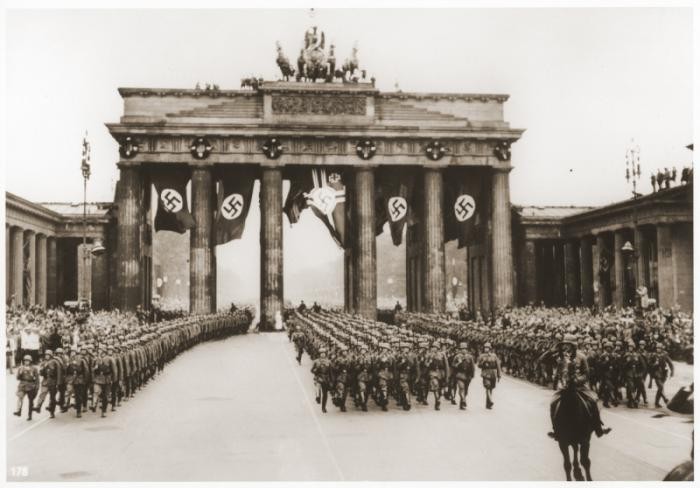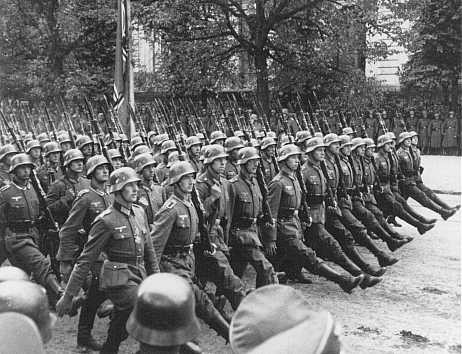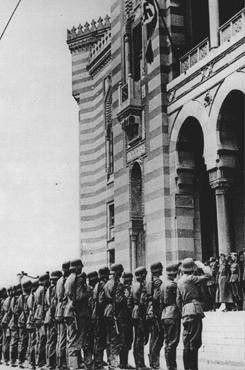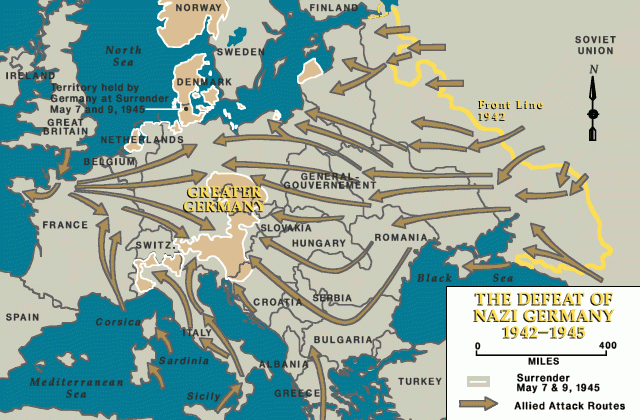
German Wartime Expansion
During the first three years of World War II, from September 1939 through November 1942, a series of military victories permitted German domination of the European continent.

In September 1939, Germany invaded Poland. Within weeks the Poles surrendered. The Germans annexed the former free city of Danzig and all of western Poland, including the provinces of West Prussia, Poznan, Upper Silesia, and Lodz (renamed Litzmannstadt). Central and southern Poland were organized into the Generalgouvernement (General Government) of Poland in October 1939.
Between April and June 1940, Germany conquered Denmark and Norway. The Germans permitted the Danish government to remain in place and govern, though elections were banned. Norway fell under the administration of a German Reich Commissar, who ruled with the assistance of German military and SS/police occupation authorities and a collaborationist Norwegian police and administration.
On May 10, 1940, German forces invaded western Europe. Luxembourg surrendered that day and was ultimately annexed to Germany. The Dutch army surrendered on May 15; the Belgians capitulated on May 28. The Netherlands was placed under a German Reich Commissar; a German civilian administration oversaw a collaborationist Dutch administration. Belgium came under German military occupation. France signed an armistice with the Nazis on June 22, 1940. By the terms of the armistice, northern France and the Atlantic coastline of France came under German military occupation, while southern France, including the Mediterranean coast, fell under the jurisdiction of a collaborationist French government led by former World War I hero Henri Petain. This regime, known as Vichy France, though nominally neutral during the war, was entirely dependent on Nazi Germany in its conduct of foreign policy and in most domestic policies as well. After the successful Allied landing in French North Africa in November 1942, German troops occupied southern France.

In March 1941, in an effort to aid its Axis ally Italy, Nazi Germany invaded Yugoslavia and Greece. Yugoslavia disintegrated within two weeks. With their Italian allies, the Germans partitioned Slovenia and annexed the northeastern part of the country, sponsored a dependent Croat state (including Bosnia-Herzegovina) under the leadership of the fascist Ustasa movement, and put Serbia under military occupation. Greece, after losing its northwestern coast to Italian-annexed Albania and Thrace to Bulgaria, was divided into German and Italian zones of occupation and placed under German and Italian military rule.
German troops also assisted their Italian counterparts in driving British forces out of Italian-controlled Libya and invading British-controlled Egypt in the spring of 1941.
In June 1941, Nazi Germany invaded the Soviet Union. After driving Soviet forces out of eastern Poland, which the Soviet Union had occupied and annexed in 1939 in accordance with the German-Soviet Pact, the Germans attached the Bialystok district administratively to East Prussia and incorporated East Galicia, the region around Lvov in southeastern Poland, into the Generalgouvernement.
Between July and early December 1941, German troops conquered the Baltic states (Estonia, Latvia, and Lithuania), Belorussia, most of the Ukraine, and large tracts of Russian territory. By early December 1941, the Germans had laid siege to Leningrad in the north, reached the outskirts of Moscow in the center, and conquered Rostov, the gateway to the Caucasus, in the south.

After suffering horrendous defeats at the hands of the Soviet army in the winter of 1941-1942, German troops resumed the offensive in the summer of 1942. By the early autumn, they had reached the geographic limits of Axis expansion: Stalingrad and the central part of the Caucasian region in the Soviet Union and El Alamein in Egypt.
When the tide of war turned against Germany between November 1942 and July 1943, German troops nevertheless continued to extend direct German rule. After the Italians surrendered to the Allies in September 1943, the Germans invaded northern and central Italy as well as Italian-occupied Greece, Yugoslavia, and Albania. In March 1944, to prevent Hungary from leaving the Axis alliance, German troops occupied Hungary. Even as Soviet troops surged across the East Prussian border into German territory in August 1944, German troops invaded and occupied Slovakia, after the Slovak resistance initiated an uprising.

Critical Thinking Questions
- How did German occupation policies differ in each country, such as Denmark or Poland? Why?
- Investigate the different levels of cooperation with and support of the occupying Nazi forces in each country. Which countries collaborated? Which resisted? Why?

